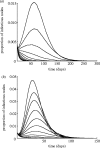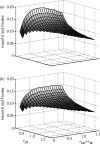Infectious disease control using contact tracing in random and scale-free networks
- PMID: 16849217
- PMCID: PMC1618487
- DOI: 10.1098/rsif.2005.0079
Infectious disease control using contact tracing in random and scale-free networks
Abstract
Contact tracing aims to identify and isolate individuals that have been in contact with infectious individuals. The efficacy of contact tracing and the hierarchy of traced nodes-nodes with higher degree traced first-is investigated and compared on random and scale-free (SF) networks with the same number of nodes N and average connection K. For values of the transmission rate larger than a threshold, the final epidemic size on SF networks is smaller than that on corresponding random networks. While in random networks new infectious and traced nodes from all classes have similar average degrees, in SF networks the average degree of nodes that are in more advanced stages of the disease is higher at any given time. On SF networks tracing removes possible sources of infection with high average degree. However a higher tracing effort is required to control the epidemic than on corresponding random networks due to the high initial velocity of spread towards the highly connected nodes. An increased latency period fails to significantly improve contact tracing efficacy. Contact tracing has a limited effect if the removal rate of susceptible nodes is relatively high, due to the fast local depletion of susceptible nodes.
Figures







Similar articles
-
The effect of network mixing patterns on epidemic dynamics and the efficacy of disease contact tracing.J R Soc Interface. 2008 Jul 6;5(24):791-9. doi: 10.1098/rsif.2007.1272. J R Soc Interface. 2008. PMID: 18055417 Free PMC article.
-
Disease contact tracing in random and clustered networks.Proc Biol Sci. 2005 Jul 7;272(1570):1407-14. doi: 10.1098/rspb.2005.3092. Proc Biol Sci. 2005. PMID: 16006334 Free PMC article.
-
Sexual networks and the chlamydia epidemic - meeting report.Euro Surveill. 2007 Oct 1;12(10):E15-6. Euro Surveill. 2007. PMID: 17997926 No abstract available.
-
Role of contact tracing in containing the 2014 Ebola outbreak: a review.Afr Health Sci. 2017 Mar;17(1):225-236. doi: 10.4314/ahs.v17i1.28. Afr Health Sci. 2017. PMID: 29026397 Free PMC article. Review.
-
Digital contact tracing technologies in epidemics: a rapid review.Cochrane Database Syst Rev. 2020 Aug 18;8(8):CD013699. doi: 10.1002/14651858.CD013699. Cochrane Database Syst Rev. 2020. PMID: 33502000 Free PMC article.
Cited by
-
Demographic structure and pathogen dynamics on the network of livestock movements in Great Britain.Proc Biol Sci. 2006 Aug 22;273(1597):1999-2007. doi: 10.1098/rspb.2006.3505. Proc Biol Sci. 2006. PMID: 16846906 Free PMC article.
-
Measuring the impact of social-distancing, testing, and undetected asymptomatic cases on the diffusion of COVID-19.PLoS One. 2022 Aug 25;17(8):e0273469. doi: 10.1371/journal.pone.0273469. eCollection 2022. PLoS One. 2022. PMID: 36006926 Free PMC article.
-
Estimation of swine movement network at farm level in the US from the Census of Agriculture data.Sci Rep. 2019 Apr 17;9(1):6237. doi: 10.1038/s41598-019-42616-w. Sci Rep. 2019. PMID: 30996237 Free PMC article.
-
Analysis of the Spatial Organization of Pastures as a Contact Network, Implications for Potential Disease Spread and Biosecurity in Livestock, France, 2010.PLoS One. 2017 Jan 6;12(1):e0169881. doi: 10.1371/journal.pone.0169881. eCollection 2017. PLoS One. 2017. PMID: 28060913 Free PMC article.
-
Beyond Contact Tracing: Community-Based Early Detection for Ebola Response.PLoS Curr. 2016 May 19;8:ecurrents.outbreaks.322427f4c3cc2b9c1a5b3395e7d20894. doi: 10.1371/currents.outbreaks.322427f4c3cc2b9c1a5b3395e7d20894. PLoS Curr. 2016. PMID: 27486552 Free PMC article.
References
-
- Albert R, Barabási A.L. Statistical mechanics of complex networks. Rev. Mod. Phys. 2002;74:47–97. doi:10.1103/RevModPhys.74.47 - DOI
-
- Albert R, Jeong H, Barabási A.L. Error and attack tolerance of complex networks. Nature. 2000;406:378–382. doi:10.1038/35019019 - DOI - PubMed
-
- Anderson R.M, May R.M. Oxford University Press; Oxford: 1991. Infectious diseases of humans: dynamics and control.
-
- Barthélemy M, Barrat A, Pastoras-Satorras R, Vespignani A. Velocity and hierarchical spread of epidemic outbreaks in scale-free networks. Phys. Rev. Lett. 2004;92:178701. doi:10.1103/PhysRevLett.92.178701 - DOI - PubMed
-
- Clarke J. Contact tracing for Chlamydia: data on effectiveness. Int. J. STD AIDS. 1998;9:187–191. doi:10.1258/0956462981921945 - DOI - PubMed
Publication types
MeSH terms
Grants and funding
LinkOut - more resources
Full Text Sources
Medical

